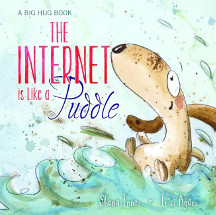The Internet is like a puddle by Shona Innes

Ill. by Irisz Agocs. Big Hug series. Five Mile Press, 2015.
ISBN 9781760064167
(Age: 4+) Recommended. Internet, Safety. Discussing the dangers that
lurk behind using the internet is one of those discussions that is
hard to initiate and even more difficult to explain. Here with The
internet is like a puddle, the opportunity is given to
teachers and parents to introduce such a topic with young children.
A clinical and forensic psychologist, Shona Innes has had many years
of experience with young children and has developed in her book a
way of involving both child and adult in presenting this theme.
The first few pages talk of the positive things the internet offers,
giving the parent and child or teacher and a class the opportunity
to look at the range offered by the internet, including the uses
made of it in class or at home. Some of the devices which allow us
to get into the internet are alluded to, and the games and
information which can be accessed are stressed. She makes it clear
that the internet is fun and can absorb a lot of time, but then goes
on to explain that the internet is like a puddle, and uses that
simile to underline the dangers that lurk there. Initially she talks
about the time spent on the internet, and extols the virtues of
being outside, of talking with friends, of exercise. She then talks
of getting further into the internet to places that are not safe,
that could show things unsuitable or entice the user to chat to
strangers.
The solution to not falling into the puddle is being with someone
who is safe, like an adult. The safety issue is stressed towards the
end of the book, and without making it an overwhelmingly didactic,
is made clear that this is the best way to have fun with the
internet.
The illustrations add to the interest of the book with animals used
as the main characters, and the soft swirly watercolour making it
easy on the eye. Children will laugh out loud at the animals as they
have some problems with the mud and deep water of the puddles but
will also understand the image presented of a child being overcome
by the unknown depth of the internet.
The ideas presented by Innes are clear and unequivocal. She leads
the reader through the positives then introduces the negative
aspects of this technology with reassurance.
This is a fascinating introductory book for class and home, allowing
communication between adult and child on an issue of increasing
importance.
Fran Knight